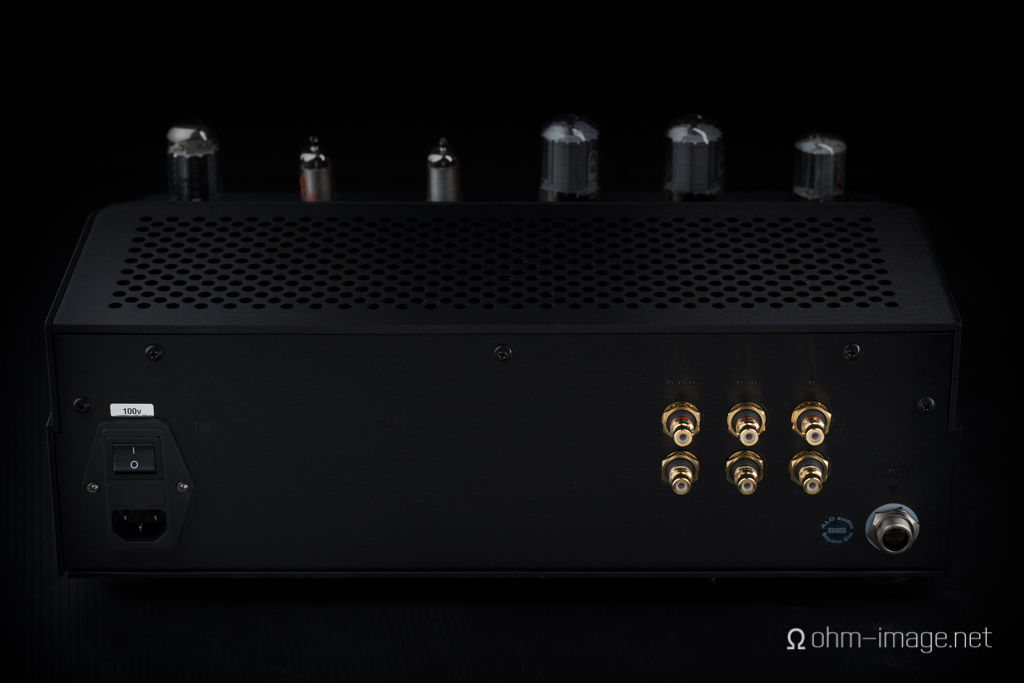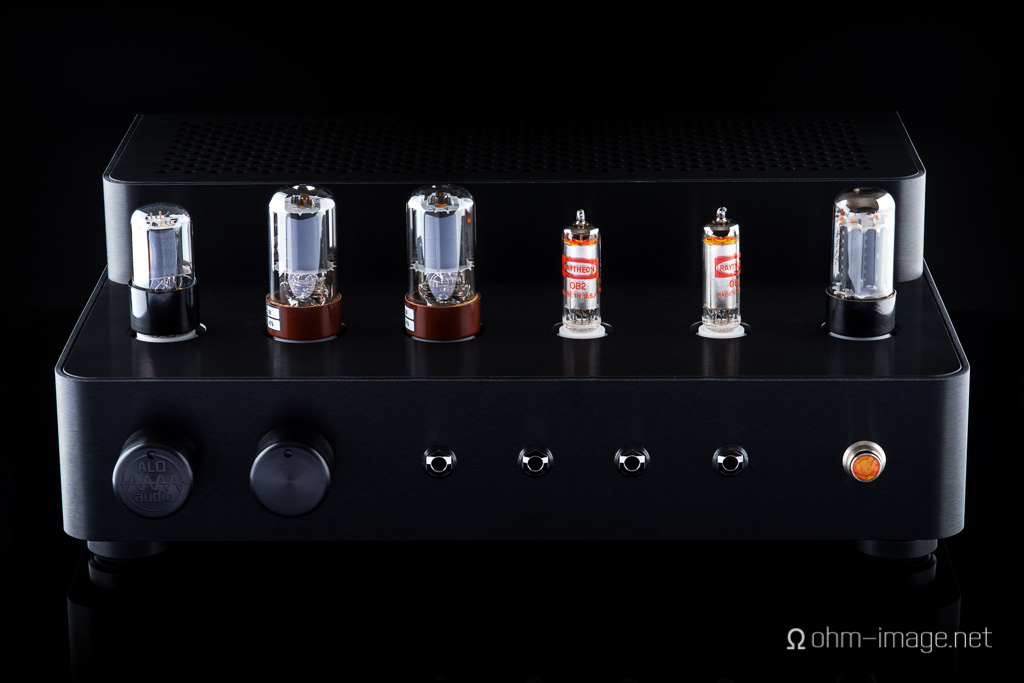Big things come in bigger packages. (And big packages generally must be scooted down the hall in push-pull spouse trains.) ALO Audio's debut desktop amp is leviathan big. Still, I managed to plop it on top of my HiFi all by my lonesome. There, at the summit of my living room, it perches from a spiritual position I believe it truly earns: the top.
Spec:
Headphone impedance compatibility range:
8 Ohms to 600 Ohms
Maximum rated output power:
1,000 milliwatts into 8 to 32 Ohms
Amplifier input impedance:
95k-Ohms
Amplifier input Voltage for full-rated output voltage into various headphone impedances:
1.00V RMS input for 4.0V RMS output into 16 Ohms
1.30V RMS input for 5.7V RMS output into 32 Ohms
1.70V RMS input for 7.5V RMS output into 75 Ohms
1.85V RMS input for 8.3V RMS output into 150 Ohms
1.70V RMS input for 8.2V RMS output into 300 Ohms
1.65V RMS input for 8.1V RMS output into 600 Ohms
THD+N (1kHz input) at 1V RMS output into stated load impedances:
32 Ohms: 0.26%
150 Ohms: 0.12%
THD+N (1kHz input) at 250 milliwatts output into stated impedances:
32 Ohms: 1.0%
150 Ohms: 2.0%
Frequency Response -3dB (Referenced to 1kHz, 250 milliwatts output) into stated impedances:
32 Ohms: 6.0Hz to 39kHz
150 Ohms: 16.5Hz to 36kHz
Frequency Response -1dB at full-rated (2.83V RMS) 1,000 milliwatt output into 8 Ohms:
15Hz to 20kHz
S/N Ratio:
78dB (unweighted) below full 2.83V RMS output into 8 Ohms
ALO Audio Studio Six: ~4.900$ USD and up
ohmage: haptics
The Studio Six pushes a Sasquatch-sized footprint into your HiFi station, but its interface is as easy as falling off a log. The front panel is graced by two large rotating knobs. The one on the left clicks between three positions which correspond to inputs. The glorious one to its right is the volume pot, which is as smoothly damped as a Leica lens. The bastard child of Rockwell and Knobfeel would glory in its silky, one-fingerable operation.
The back panel arrays gold-plated RCA inputs directly behind the input selector knob. A mysterious port dubbed Accessory Power Connection sits below. Opposite it are the volume switch and accompanying ATX port.
The Studio Six is single-ended, in and out.
ohmage: kitsch
Here at KitschWatch, we approach things like glitter, buffed plastic, chromed polyurinethane, and so on, with thumbs turned way down. My nose says that ALO, too, are anti-kitsch. The Studio Six is laser etched, bolted, and bent to precision. Its knobs are precise and damped, and its inputs are so firm in the chassis they are practically part of it.
ALO make one thing very clear: that you know this amp was made by them. It was designed and built in the USA, and it is made to last.
ohmage: build quality and finish
Hinted at above is a build that amounts to nothing less than ponderous quality. It is a quality that, on the one hand, conjures up the lastingness of a WWII German tank, and on the other, the iterative polish of a Leica M. Every piece is solid, perfectly balanced, and just as impeccably as it is produced, it is branded with ALO's now famous marque.
The power indicator in its silver ballast warmly glows in orange, matching the Studio Six's glowing valves. The knobs reflect light in gentle waning crescents. Even the bolts that secure the headphone outputs and RCA inputs are secured at the same angle. In photographs, the Six intoxicates.
Its balance between simplicity and utility is almost poetically Leitz.
Unfortunately, the Studio Six sticks out so much because the importance of beautiful and precise manufacturing has been supplanted by expedience and outsourcing. The non-artisan's motto of "as long as it performs well..." resounds in clangy, ill-finished lumps of metal and plastic, as devoid of unity as they are of vision.
At least they perform well...
Since the very beginning, ALO Audio instilled into every product the goals of craftsmanship and precision. And most of their line performs as good or better than the competition.
The one improvement I can think of is adding corresponding ticks to the input selector knob.
Sound: ohmage
Typical ALO amps can be divided into two camps: the benchmarker and the powerhouse. The Rx series forged new benchmark ground at its launch its inception, toppling many a top performer along the way. More recently, The International, and it similarly housed brother, The Continental, have impressed with power and warmth.
The sound of the Studio Six is a marriage of the two. It has limitless power, but on the other end, it is nearly limitless in headphone driving performance.
Power
If ALO's main aim was bragging rights, they nailed it. Studio Six supplies limitless power to the widest variety of headphones I have observed in a single full-sized HiFi headphone amp. High-ohm HiFi favourites like the T1, HD800, DT880, and Maddog, run flawlessly from minimal casual listening volume levels to maximal in-the-next-room-and-still-loud volume levels. At no listening volume does any headphones crackle or sizzle.
I have not tried the K1000 with the Studio Six, but I suspect it may have found its first non-power amp match.
More impressive is the Studio Six's ability to drive current-hungry PS500, LCD-2/3, HE-500, and their like, at any volume, sane or insane, with the same purity of signal. The is no audible nor measurable drop in output performance with any modern or classic home headphone. This trend continues on down the line until, at last, you reach inner ear monitors and portable headphones, whose high-current requirements take their toll on an amp that primarily is designed for home headphones.
The effect is a slight loosening of the Studio Six's otherwise tight frequency response. Low ohm portable headphones gain a slight boost in the 100Hz range, and armature earphones throw the Six off at the crossover level to the maximum of about 2dB at maximum. Put into context, such artefacting is laughable. The Six is better able to drive low ohm earphones than ALO's own Continental series of portable headphone amplifiers is. Ditto a large number of dedicated earphone amplifiers out there.
I ran a torture test consisting of the following array: DT880, PS500, HE500, SM2 (yes, those amp-killing earphones) and noticed no untoward current or voltage drops. Of course, concurrent parallel playback of multiple headphones only makes sense when every model is the same. But the Six demonstrates that it an handle anything in any combination.
As for input power, you can basically hook up anything from an iPod to strong line-level mixing boards and should experience no input overload.
Balance
The Six spreads it power quite evenly. It has gentle low and high pass filters on either frequency extreme independent of loads. They measure at less than minus 2dB and start rolling off at 100Hz and 12kHz respectively. I don't think they could be considered audible without a rigorous (and placebo inducing) dose of measurebating.
Tracking
Personally, I find most impressive the Six's almost flawlessly ability to track between any headphone. Naturally, there is no detectable left/right difference for any typical HiFi headphone. Even sensitive IEMs track at usable levels. The volume pot, whose long gain throw allows fine left/right tuning is part of what makes this possible. The other part is the Six's overall modest gain that defers control and power to the volume pot.
Bass vs. Mids
Valve-based amplifiers tend to smooth out some details, preferring warmth and 'musicality' to minutia. The Six's clearest and most powerful frequency is its midrange where signal clarity and strength are best. Signal noise is very low for a valve amp. More impressive is the Six's ability to separate left from right with keen precision. Stages are vast, but not cutting.
Small details are clear but don't draw untoward attention. I found the Six loves live. Neil Young is probably one of its favourite artists. But the Six is no slouch when it comes to modern electronic music, either. Decent rise time puts it in good standing for trance, IDM, and double-speed John Denver discs.
Of prime beauty are chimes, high strings, cymbals, and the brassy, shimmering, strumming like. Bass is slightly less clear, bit its performance follows the same general principles. It is wide, fast, and able to resolve the important details. But by a hair, mids are king, and they are absolutely stunning.
Bass vs. Highs
These frequencies really are equal. Both contain a little more of that special dose of musicality that the mundane reviewer would read as valve distortion. There is no way around it: valves output more THD per volt than their solid state brethren. Those who like that distortion, like it a lot.
I have begun to prefer valves for live performances, and, more recently, for violin concertos and IMD Forum purchases. Why? Reality. Headphones tend to dissect things too much, unnaturally hiding left/right information, especially in complicated recordings. The Six doesn't cross feed channels, but the warmth from its valves smartens up otherwise too-headphoney of signals.
Vs. Low impedance
As mentioned above, Six is absolutely rock solid. Only very low ohm earphones can trip it up, and only just. Most valve amps throw good voltage swings but don't hold up quite so well when driving variable loads.
Vs. High impedance
Again, no problems here. The Six is more than able to toss around your least sensitive, voltage-hungry cans. I've encountered no headphone (or combination of headphones) that even remotely trips this amp up. It is more than capable of turning any headphone into desktop speakers. In fact, I am confident that the Six could run sensitive speakers with little problem.
Personal favourites are the Grado PS500, the T1, and the LCD-2, each of which sing so wonderfully through the Studio Six.
The Studio Six isn't just an amp. It is a statement, that punctuated by precise engineering, utilitarian design, and excellent performance, has other amps blubbering. No, it isn't a balanced amplifier. It is The single-ended amp, tweaked and perfected. ALO proved yet again that they are not merely product designers. They are tinkers. They are engineers. They are artisans. And crowning their panoply of amps, cables, and more, is the Studio Six, an exact, performance-oriented amp which proves that ALO are in it for nothing less than to change the industry.
ohmage: 4
porridge: 1






